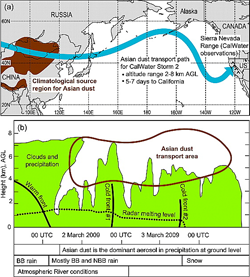
Click image for more detail
|
|
Contact: Allen White
|
HMT Publication Notice
This paper discusses the observation of Asian dust in California precipitation during the first phase of the CalWater field experiment (CalWater Early Start), a collaborative effort between NOAA, Scripps Institution of Oceanography at the University of California, San Diego (SIO/UCSD), and the California Energy Commission. This study brought together advanced aerosol chemical characterization techniques (aerosol time-of-flight mass spectrometry), meteorological measurements (in conjunction with NOAA's Hydrometeorology Testbed, satellite measurements of synoptic scale integrated water vapor (specifically atmospheric rivers), and back trajectory analysis (FLEXPART). Two storms were used as case studies, which produced 23% of the annual precipitation and 38% of the maximum snowpack during water year 2008-2009. Asian dust was observed in precipitation samples during the second storm via single-particle mass spectrometry and confirmed using back trajectory analysis. Meteorological differences between the two storms were investigated with respect to atmospheric river conditions, integrated water vapor, and cloud properties (from S-band radar), as well as precipitation type, rate, and volume. Discussions of potential impacts of Asian dust acting as ice nuclei on cloud properties and precipitation, which could have potentially large impacts on California's water supply, from these case studies are discussed. Further measurements involving subsequent CalWater field seasons and modeling efforts are building on the initial findings from these CalWater Early Start results.
 Read the Abstract
Read the Abstract